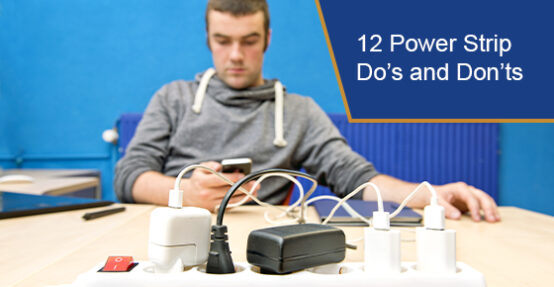
Most homes today have a variety of tools and toys that demand a lot of electricity. Whether you are in a home, apartment, or mobile home, having enough power outlets can be a challenge. It’s likely you have extension cords and power strips to help you power up your home. However, safety becomes a big issue when you use power strips. Therefore, it’s vital that you understand the do’s and don’ts of using these cords.
While they both help distribute power from a single outlet, a power strip is more durable. Power strips also have more sockets than extension cords. Most extension cords have one, two, or three plugs. While these cords are longer and can stretch farther, they are meant only to be used for a short time, for example, around an hour or so.
Although power strips have a shorter cable, they can be used for much longer than an extension cord, but there are some do’s and don’ts when it comes to using power strips. Here are some tips to keep you and your home safe when using power strips.
Using a power strip to distribute electricity around your house can be helpful, especially when you don’t have enough outlets. However, it’s important to do it safely. Here are 12 ways can you do just that:
Power strips are capable of handling small household items like a lamp or computer. They were not designed to be used for major household appliances like a fridge or dishwasher.
Unlike extension cords, power strips can be used for an extended time. However, if you’re relying on a power strip for many weeks or months, then it may be more practical to call in a professional to add outlets to your system.
Use power strips that have surge protection to keep your devices and your electrical system safe. Power surges and power shorts have the capability to damage the power strip and items that you have plugged into it. To limit this possibility, keep your power strip away from moist areas.
One drawback to power strips is the short cable. However, trying to get around this problem by plugging extension cords or other power strips into each other is dangerous. It may result in damage to your devices or even an electrical fire.
It can be frustrating when you don’t have enough power outlets in your bathroom for all your devices, such as curling iron, blow dryer, etc. Using a power strip to solve the problem, though, is not the right solution. These items draw a lot of electricity, which is a risk. They should only be plugged into an outlet.
There are several kitchen appliances that should not be plugged into a power strip, including:
Any appliance that draws a lot of electricity to operate presents a safety hazard. In the case of the slow cooker, it draws power for a long time, which is why you should avoid using a power strip with it.
Trying to warm up a room can be frustrating on cold nights, but using a power strip with a space heater could cause a fire. These appliances require a lot of amps to run and should only be used in a wall outlet.
Power strips will be labeled for indoor or outdoor use. They are designed differently depending on their intended use. It’s important not to use an indoor power strip outside. These power strips don’t have the capacity to stand up to harsh weather or water, and you could end up destroying your appliances or worse.
Power strips can be eyesores and ruin the decor or ambiance you are trying to create in your space. However, hiding it under a carpet puts you at higher risk of fire. The amount of heat that is generated by a power strip can cause a fire if it is put under a rug or in a tight space. Moreover, if you step on it, you could damage it, thus resulting in an electric shock.
If you notice that one of the sockets on the power strip is damaged or not working, then don’t try and use another one beside it. The damage could be a sign there is internal damage in the power strip. Continuing to use it will create a fire hazard.
Electricity and water do not mix. If your power strip gets wet, then it could hurt you and damage anything that is plugged into it. This means be mindful of the area around the power strip and ensure there is no risk that it will come into contact with water or other liquids.
Kids in your home should be taught not to play with power strips. These types of tools can be just as dangerous as wall outlets, and could present a safety risk for young children, toddlers, and babies who may try to stick things inside of the sockets.
Power strips and extension cords can be useful tools for short-term electricity distribution, but they are not a long-term answer to your problems. If you find yourself too dependent on these devices, then it’s time to call a professional to help you solve your electrical problem in a safer way.
For more information about updating your electrical system or if you want to speak with a licensed electrician in Toronto, call Hi-Lite Electric at 416-800-5523, or contact us here.
© 2024 Licensed Electrical Installation & Service – Hi-Liteelectricinc.ca
All Rights Reserved.
Leave A Comment